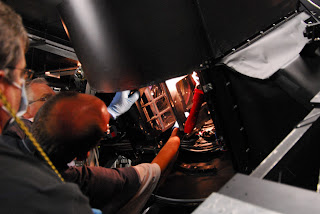The optic that's suffered the most as a result of the RSS lens fluid nightmare is the beamsplitter. This incredibly intricate assembly's made up of 18 UV calcite prisms arranged in a 3x3x2 array, with coupling fluid filling the gaps between the pairs of prisms.
Calcite is a birefringent crystal & thus splits light up into 2 linearly polarised components, known as the ordinary & extraordinary rays. The fact that RSS is designed to operate all the way down to the atmospheric cut-off means that UV-transmissive calcite's required & that's extreeemely rare. In fact, these crystals were mined in a really dodgy part of Mexico & the individual chunks are amongst the largest specimens in the world.
The prisms all had to be precisely aligned so that they produce a clean pair of images, rather than a jumble of variously offset versions. Happily, this all looks good!
Although it does manage to produce some rather funky effects - here's a light bulb shining down on its surface at an angle. Spot the dispersion due to the prisms & the reflections off the various surfaces.
As happened with the collimator optics, an air bubble appeared in the lens fluid & this had to be herded out of the optical path. A small amount of air was probably trapped within the network of channels inside the frame that holds the whole thing together. While traveling up to altitude, the bubble grew & migrated out of its hiding place...
Tipping, tilting & tapping the frame eventually chased the bubble up into the fluid storage bladder at the top of the frame, where it ought to stay.
While the beamsplitter was away having its lens fluid replaced & then being repaired, a chunk of aluminium was installed in its place.
This served to protect the huge front element of the spectrograph camera that otherwise would've been scarily exposed to all the mechanical interventions going on nearby.
So - time to insert the beamsplitter!
Note the yellow rope in the background that's doubled when seen through the optic...
It just wouldn't be a real SALT instrument without the obligatory limited-space/tortured-access issues!
Nothing Peter can't handle though...
Once it was safely mounted we could test the pneumatics that lift & lower the beamsplitter. When not doing polarimetric observations, the beamsplitter will be stowed above the beam.
A slitmask with a set of pinholes was inserted into the beam & an image taken. The frame showed the pinhole pattern repeated (albeit in the form of slits) & off-set in the vertical, indicating that all is well. Obtaining an image with a narrowband filter in the beam confirmed that the small slits are due to dispersion by the prisms.














No comments:
Post a Comment